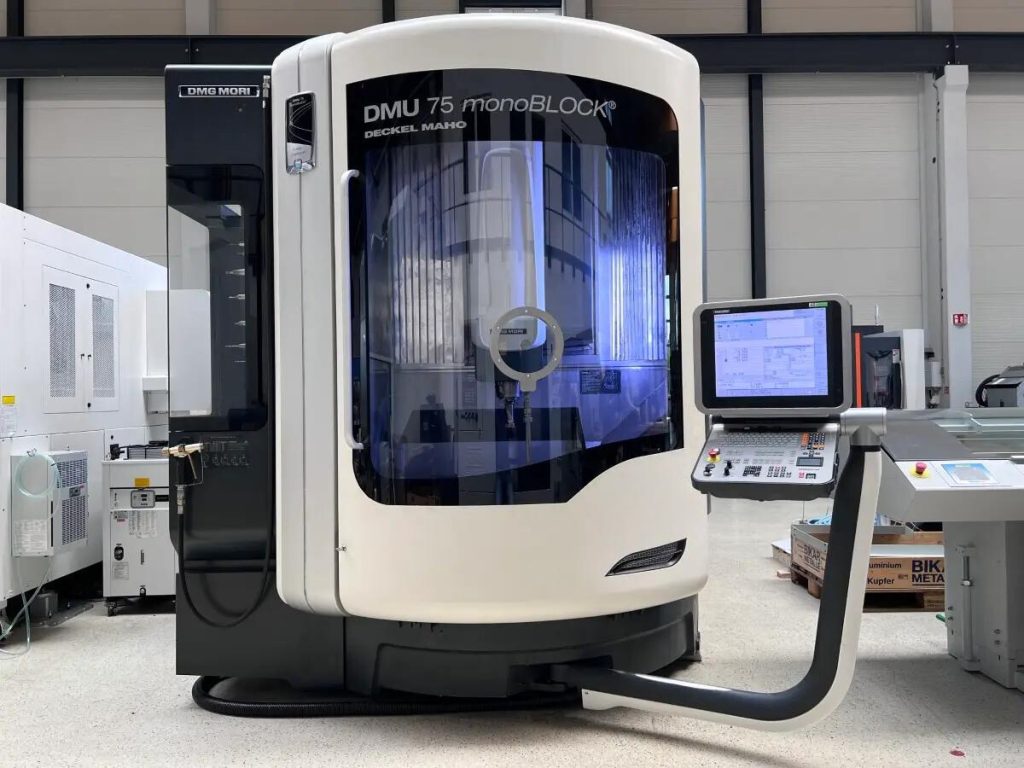10/08/2024
What are the Technical Details to be considered before buying a DMG MORI DMU 75 monoBlock CNC 5-Axes Vertical Machining Center made in Germany?
When considering the purchase of a DMG MORI DMU 75 monoBlock CNC 5-Axes Vertical Machining Center, several technical details should be evaluated to ensure the machine meets your production needs and expectations. Here are 25 key technical aspects to consider:
1. Machine Build and Construction
- Monolithic Design: The monoBlock construction provides rigidity, which is crucial for precision machining and minimizing vibrations.
- Material of Construction: Typically made from cast iron or similar high-damping materials for stability.
2. Axis Configuration
- 5-Axis Configuration: Simultaneous movement in X, Y, Z axes along with two rotary axes (B and C) for complex geometry machining.
- Axis Travels: Evaluate the X, Y, and Z axis travel ranges (750 mm x 650 mm x 560 mm respectively) to ensure they match your workpiece dimensions.
- Rotary Table: Check the rotary table size and its load capacity.
3. Spindle Specifications
- Spindle Speed: Check the maximum spindle speed (up to 18,000 RPM for high-speed machining).
- Spindle Power: Spindle motor power (e.g., 15 kW) to ensure it meets the requirements for your material and cutting conditions.
- Spindle Torque: Ensure the torque is sufficient for heavy-duty cutting.
- Spindle Taper: Verify the spindle taper type (e.g., HSK-A63) for tool compatibility.
4. Tool Magazine
- Tool Capacity: Number of tools the magazine can hold (typically 60 tools or more).
- Tool Change Time: The time required for tool changes (e.g., 1.6 seconds) affecting cycle time.
- Tool Management System: The ability to manage and track tool life and tool position.
5. Accuracy and Precision
- Positioning Accuracy: Typically measured in microns (±0.008 mm).
- Repeatability: The machine’s ability to repeat positions (e.g., ±0.005 mm).
- Thermal Compensation: Systems to compensate for thermal expansion ensuring consistent accuracy.
6. Control System
- CNC Controller: Check the version of the Siemens, Heidenhain, or DMG MORI’s proprietary control system.
- User Interface: Evaluate the ease of use, programming capabilities, and available software.
- Dynamic Collision Monitoring: Integrated systems to prevent collisions during operation.
7. Workpiece Handling
- Workpiece Size and Weight Capacity: Maximum size and weight the machine can handle.
- Clamping System: Type of workpiece clamping (hydraulic, pneumatic) and its flexibility.
8. Coolant System
- Coolant Delivery: High-pressure coolant systems for effective chip removal and cooling.
- Filtration System: Ensuring the coolant is properly filtered to avoid contamination.
9. Chip Management
- Chip Conveyor: Type of chip conveyor (hinged belt, scraper) and its effectiveness in chip removal.
- Chip Size and Shape Compatibility: The machine’s ability to handle various chip sizes and shapes.
10. Automation and Integration
- Automation Readiness: The machine’s ability to integrate with automation systems like robotic arms or pallet changers.
- Software Integration: Compatibility with CAD/CAM systems for seamless workflow integration.
11. Drive Systems
- Direct Drive Motors: For high precision and fast axis movements.
- Linear Guides: Ensure the quality of linear guides and ball screws for smooth movement and longevity.
12. Energy Efficiency
- Power Consumption: Check the overall energy consumption during operation.
- Regenerative Drives: Systems that recover energy during deceleration.
13. Safety Features
- Safety Enclosures: Ensure the machine is fully enclosed with safety interlocks.
- Operator Protection: Features like automatic shutoff in case of abnormal operation.
14. Machine Footprint
- Size of the Machine: Ensure the machine fits within your available floor space.
- Foundation Requirements: Check if special foundations are required due to the machine’s weight or operational vibrations.
15. Vibration Dampening
- Anti-vibration Technologies: Systems in place to minimize the effect of vibrations on machining accuracy.
16. Environmental Conditions
- Temperature and Humidity Tolerance: Ensure the machine can operate efficiently within your shop’s environmental conditions.
17. Maintenance Requirements
- Ease of Maintenance: Access to critical components for maintenance and the availability of diagnostic systems.
- Lubrication System: Automatic lubrication systems for consistent maintenance.
18. Software Features
- Simulation Capabilities: Ability to simulate machining processes to prevent errors.
- Adaptive Control: Software that adjusts machining parameters in real-time based on cutting conditions.
19. Machine Load and Dynamics
- Machine Dynamics: Ability to handle dynamic loads during high-speed machining.
- Dynamic Stiffness: Resistance to deflection under heavy cutting loads.
20. Tooling Compatibility
- Tool Holder Compatibility: Compatibility with existing tooling (e.g., shrink fit, collet chucks).
- Tool Length and Diameter: Maximum tool dimensions that the machine can handle.
21. Power Supply Requirements
- Electrical Specifications: Voltage, current, and phase requirements for installation.
- Power Backup: Availability of UPS systems to protect against power outages.
22. Lubrication System
- Type of Lubrication: Ensure the machine uses appropriate lubrication (centralized or manual) for its components.
23. Noise and Vibration Levels
- Operational Noise: Noise levels during operation, ensuring compliance with workplace regulations.
- Vibration Levels: Machine’s vibration characteristics under different machining conditions.
24. Backup and Recovery
- Data Backup: System to backup CNC programs and machine settings.
- Error Recovery: Features that allow the machine to recover from errors without damaging workpieces.
25. Warranty and Support
- Manufacturer Warranty: Length and terms of the warranty.
- Technical Support Availability: Access to local service centers and availability of spare parts.
Evaluating these technical aspects will help ensure that the DMG MORI DMU 75 monoBlock CNC 5-Axes Vertical Machining Center you consider purchasing aligns with your production needs and expectations.


